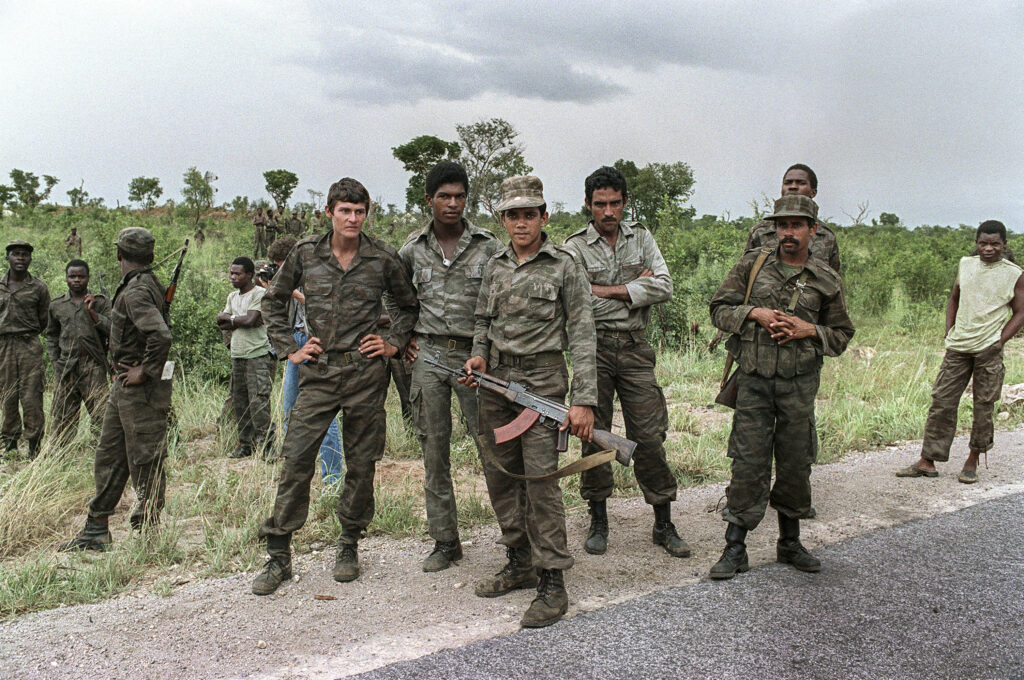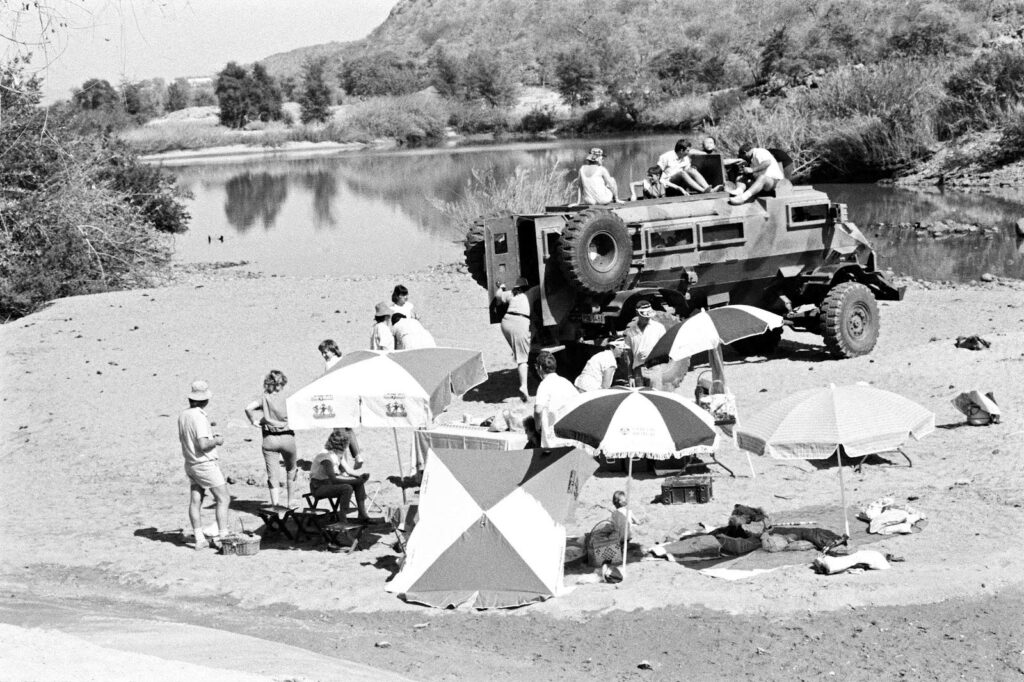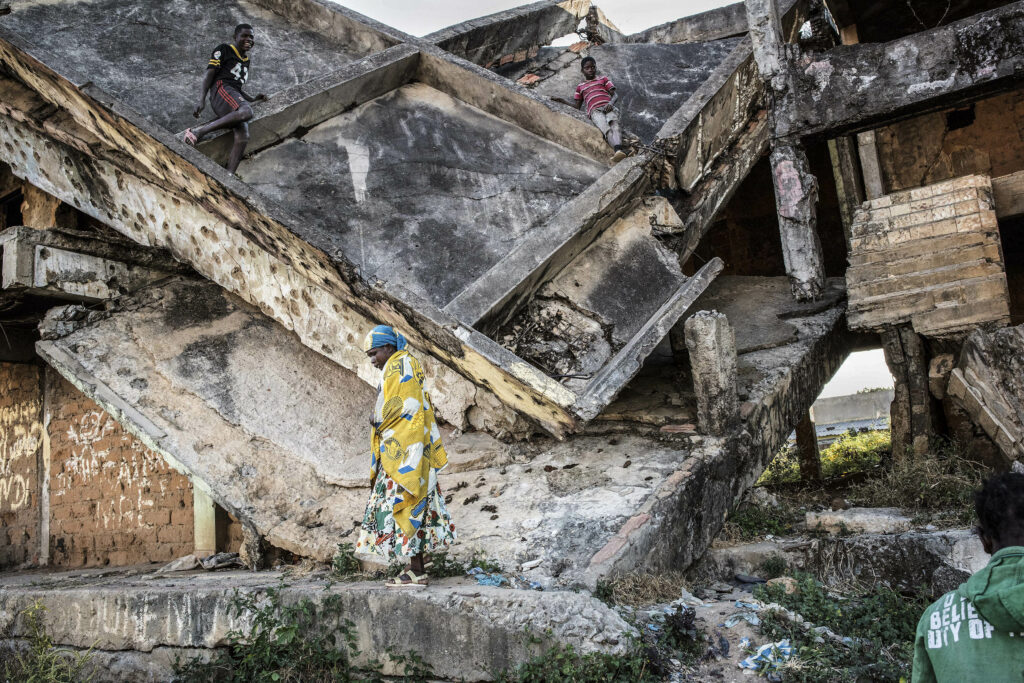29 February 1988: An Angolan soldier holds a Soviet-made AK-47 Kalashnikov assault rifle as he guards a battery of Soviet-made ground-to-air missiles near Cuito Cuanavale. (PASCAL GUYOT/AFP via Getty Images)
There are more lies and distortions about the battle of Cuito Cuanavale, on all sides, than any other recent event in Southern African history.
Let’s start with the Cubans. In International Brigades Against Apartheid, published last year, the Cuban official, Hector Igarza Cabrera, claims the Angolan and Cuban defenders of Cuito “gave the coup de grace to the South African army, which withdrew definitively from Angola, tail between legs”.
Cranking up the triumphalist hype, Rodolfo Benitez Venson, the former Cuban ambassador to South Africa, writes of the “crushing defeat of the racist army at Cuito Cuanavale”.
No credible account suggests the South African Defence Force (SADF) was dealt a “coup de grace” — death blow. It would be deeply satisfying if it had suffered a crushing defeat and been ejected from Angola in a panic-stricken rout. Alas, that did not happen.
The South Africans continued tormenting Cuito with long-range artillery fire long after the last infantry battle in March 1988. A month later, a BBC correspondent reported seeing 200 shells rain on the shattered town in three hours.
The SADF’s Battle Group 20 remained to guard minefields laid to stop the Angolan army, Fapla, breaking out of its bridgehead. Only after August 10, under the tripartite Geneva Protocol, did South African troops withdraw completely.
 Cuban soldiers providing support to the Angolan regular army and the Soviet-backed MPLA patrol near the conflict zone in southern Angola. (Photo by PASCAL GUYOT / AFP)
Cuban soldiers providing support to the Angolan regular army and the Soviet-backed MPLA patrol near the conflict zone in southern Angola. (Photo by PASCAL GUYOT / AFP)
At the other end of the political spectrum stands the nine-part documentary Born to War by Kevin Hamann, flighted last year, which follows the pattern among former SADF officers and right-wing analysts of claiming Cuito was a South African victory.
Race, an invisible presence, hovers over the military judgments. For the left, the SADF was a monument to bullying white arrogance, and Cuito a symbolic racial equaliser.
Thirty-five years after the battle, conservative whites still feel the need to assert the SADF’s unmatched military prowess in Africa — that it never lost on the battlefield despite being hugely outnumbered and hobbled by sanctions.
Their account of Cuito seems more fundamentally distorted. It relies on three sleights of hand: an inordinate focus on the initial engagements, misleading casualty figures and a version of the final settlement that overstates South African gains.
Initially, the SADF’s Operation Moduler had a limited purpose: to block Fapla’s August 1987 offensive on the Unita-held town of Mavinga, leading to a strike on Unita’s headquarters, Jamba, the following year.
Planned as a covert intervention, it would be presented as the work of its junior partner, Unita. It would not be a single battle, as some seem to think, but an eight-month campaign with fierce intermittent fighting. In the wilds of Angola, it was to be a high-tech affair.
After the SADF failed incursion in 1975, when Cuban rockets decimated its FNLA ally outside Luanda, South Africa embarked on a frenzy of arms development.
In the Cuito battle the SADF would test the new G5 howitzer, accurate at up to 40km; the world’s first wheeled tank-busting vehicle, the Ratel; the Ingwe laser beam-riding guided anti-tank missile; the Raptor glide bomb, used against the Cuito River bridge; and even a drone.
Hostilities in the south-east had become an annual ritual of the Angolan civil war. Fapla offensives in the three previous years had miscarried, largely because of SADF backing for the supposedly anti-communist Unita, which helped it maintain a cordon sanitaire across southern Angola against Swapo (South West Africa People’s Organisation) infiltration.
This was to be an all-out effort: under Soviet command 14 Angolan/Cuban brigades took part, backed by a billion dollars of Soviet hardware including T-54 and T-55 tanks and MiG-23 jet fighters.
All commentators agree that they were stopped by SADF artillery and armour at the Lomba River, with devastating losses of men and matériel. The Soviets pulled back their officers and advisers, leaving Fapla essentially leaderless.
At this point, arch-militarist PW Botha arrived on the battlefield. Flushed with the success of South African arms and seeing an opportunity to annihilate the army of Angola’s Marxist government, he gave his generals a free hand to go on the offensive.
During their retreat to Cuito Cuanavale, with the enemy snapping at their heels, Fapla inflicted the first reverses on the SADF. Slipping encirclement at the “Chambinga Gap”, named after the heights above Cuito, they regained the town as a mauled but still integral force after five bloody clashes in November.
The 14 November fight was especially important: if the Fapla brigade had been annihilated, argues analyst Leopold Scholz, the entire balance of the war, and future talks, would have tilted strongly in South Africa’s favour.
Critical to Fapla’s survival, and the battles to come, was Cuban air dominance, which made it hazardous for the SADF/Unita to move in daylight and disrupted the SADF’s “air-land” campaign.
Based a few flying minutes away at Menongue to the north-west — SADF guns quickly knocked out the Cuito airstrip — the MiGs were faster, better armed and more manoeuvrable than the ageing South African Mirages, which were operating at the limits of their range.
Armscor could not remedy this damaging infliction of the international arms embargo. Bereft of armour and artillery, the five Fapla brigades defending the approaches to the town east of the Cuito must have viewed the new year with trepidation.
Then Cuban leader Fidel Castro decided to make a symbolic stand at Cuito. Responding to pleas by the Angolan government and without informing the Soviets (they and the Cubans were frequently at loggerheads, notably over the wisdom of the Mavinga campaign), he transfused 15 000 of Cuba’s best soldiers and a flood of new armaments into the war effort.
In January, 1 500 Cubans arrived to reinforce the Cuito garrison.
The SADF and Unita, increasingly deployed as infantry to dispel the impression that this was a South African war, launched six major assaults on Fapla’s multiple defensive lines in January and February. They failed to break through.
Supplies and munitions continued to be drip-fed into the town along the Menongue road, which was repeatedly attacked but never cut.
Under Cuban commander General Cintras Frias, the defenders withdrew to the 30 square kilometre Tumpo Triangle, which they fortified in depth with extensive anti-tank minefields, bulldozer-created zones of fire and artillery coverage.
Three further offensives foundered. In the last, over 15 hours on March 23, Unita took heavy casualties and two 50-tonne SADF Olifant tanks were disabled — one having its suspension blown into the air by a boosted mine.
“Fapla was now a formidable enemy that had withstood two assaults and was confident in its defences,” writes one commentator. The SADF’s extended supply lines and shortage of specialised spares began to tell — only one battery of G-5s was now serviceable.
Retiring to a holding position, the South Africans would attempt no further attacks.
The SADF chief, General Jannie Geldenhuys, treats the Cuito battles as a minor mopping-up operation following the Lomba River battle, insisting the primary objective of stopping the Fapla push on Mavinga had been achieved and the capture of Cuito and further advances were never intended.
 Families of Koevoet members, set up by the South African Police security branch and comprising South Africans (below) and Namibians, picnic on the Kunene River near Ruacana. Photo: John Liebenberg/courtesy the Liebenberg family
Families of Koevoet members, set up by the South African Police security branch and comprising South Africans (below) and Namibians, picnic on the Kunene River near Ruacana. Photo: John Liebenberg/courtesy the Liebenberg family
Why, then, did the South Africans pursue Fapla all the way to Cuito, nearly 200km away? Why did they throw wave after wave of assaults at its defences? Unita, which prematurely announced it had taken the town, clearly thought that was the aim; SADF documents indicate that it was considered an option.
On 8 January, Geldenhuys proclaimed the South Africans would withdraw once the defenders east of the Cuito River were destroyed, presumably to head off further drives on Mavinga/Jamba. That was never achieved.
Measured by any strategic objective, Operations Hooper and Packer — the January to March phase of the battle — were a major South African setback.
Also heavily emphasised by the SADF and its promoters is the disparity between their overall estimate of South African casualties (31 killed) and those of Fapla (4 785 killed).
There can be no doubt that the Angolans suffered terribly and took many months to recover. But even if the figures are accurate, the comparison dishonestly elides the sparing use of the South African infantry and the 3 000 or more Unita dead.
Colonel Jan Breytenbach, the SADF’s 32 Battalion commander, commented after the March 23 battle that “Unita did a lot of dying that day.”
White casualties, and the political fallout back home, were what counted for the South Africans. When the SADF pulled out of Angola in August 1988, Unita soldiers are said to have wept over what they saw as a betrayal.
The balance sheet of military-political outcomes highlights the thin pickings for South Africa and the remarkable gains of its enemies.
The SADF indeed saved the bacon of power-intoxicated tribalist Savimbi. The main long-term effect was to allow the civil war and Unita mayhem to continue long after the SADF quit Angola and South West Africa, now Namibia — and, therefore, long after Unita could serve any conceivable South African security interest.
Savimbi was killed in a Fapla ambush in 2002, and Unita — once the darling of the American right, now under US arms embargo and condemned by president Bill Clinton as an “unusual and extraordinary threat” to US foreign policy — immediately sued for peace.
It currently holds 51 seats in the 220-seat national assembly. The Soviet flag ceased to flutter over the Kremlin in 1990 and the ruling MPLA renounced Marxism-Leninism at its 1991.
Botha’s claim that the Angolan conflict was between “atheistic communism” and “the Free World” was deluded.
The other supposed South African gain was the Cuban departure from Angola, agreed between the US, Cuba, Angola and South Africa in December 1988.
The obvious point is that the Cubans were there only because of a pattern of South African incursions throughout 1975-88 against “Soviet clients” Swapo and the MPLA, which intensified under Botha.
But there was more to it. South Africa had consistently refused to quit Angola before the Cubans, yet the last Cuban troops would leave in July 1991 — almost two years after the full SADF pullout.
There was a similar vertiginous climbdown on Namibia. As late as 16 March 1988, Business Day reported that Pretoria was “offering to withdraw into Namibia — not from Namibia — in return for the withdrawal of Cuban forces from Angola. The implication is that South Africa has no real intention of giving up the territory any time soon.”
Yet the implementation of United Nations Resolution 435 was signed and sealed a few months later.
 A woman passes by as children play on a derelict building, damaged during the Angolan civil war, on June 2, 2019, in Kuito, Bie Province in central Angola. (Photo: RODGER BOSCH/AFP via Getty Images)
A woman passes by as children play on a derelict building, damaged during the Angolan civil war, on June 2, 2019, in Kuito, Bie Province in central Angola. (Photo: RODGER BOSCH/AFP via Getty Images)
In October 1985, Angolan leader José Eduardo dos Santos told the United Nations General Assembly that over four years South Africa had committed 4 000 breaches of Angolan air and ground space, including 168 air attacks and 100 land invasions.
South Africa left Angola with the Cubans in situ; abandoned its long-time ally, Unita; yielded on Namibian independence after a 73-year occupation; and accepted Swapo leader Sam Nujoma, its nemesis, as Namibia’s first citizen.
Only Angola’s new military conditions could explain such a sudden, sweeping change of heart.
The effect of the Cuito battle was compounded by the second phase of Castro’s plan — the opening of a new front in south-west Angola on 9 March, with 40 000 Cuban soldiers and 600 tanks advancing on the Namibian border. He likened this to a boxer “blocking a blow with the left hand [Cuito], while striking with the right”.
It was probably a feint — Castro seems to have had no appetite for an invasion. But coupled with a MiG bombing run that killed 11 soldiers guarding the Calueque Dam, it spooked the apartheid government into calling up 140 000 citizen force members. For the first time, the Botha government faced the prospect of large-scale conventional warfare and engagement on two fronts, with the potential for many white casualties. Its nerve cracked.
Cuito Cuanavale was not a “crushing defeat” for the SADF. It climaxed in an Angolan/Cuban defensive victory, on a far smaller scale but similar to the battle of the Kursk salient on the Eastern Front in 1943, from which the Wehrmacht never recovered.
A signal setback for South African arms, it helped to undermine South Africa’s military confidence and belief in military solutions for political problems. As such, it reverberated across the entire region.
Drew Forrest is a former deputy and political editor of the Mail & Guardian